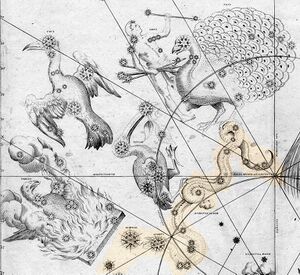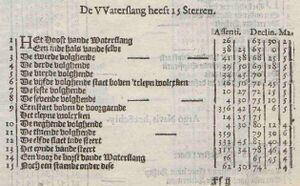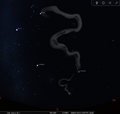Hydrus: Difference between revisions
| Line 32: | Line 32: | ||
|Lacaille |
|Lacaille |
||
|1756 |
|1756 |
||
|l' |
|l'hydre male |
||
|Male Water Snake |
|Male Water Snake |
||
|} |
|} |
||
Revision as of 05:24, 31 October 2024
One of the 88 IAU constellations. The constellation Hydrus, known as the Lesser Water Snake, is located in the southern celestial hemisphere, positioned between the Large and Small Magellanic Clouds. It is notable for being near the celestial south pole.
Etymology and History
The often-cited analogy to the great water snake is not convincing because the constellation looks completely different. A ‘snake line’ is also unimaginative as any collection of points can ultimately be connected to form a snake line.
Hydrus begins next to Achernar, the brightest star in the constellation River. The star we call Achernar today was only added to the river later; on European maps it is only found in early modern times. The Arab Bedouins may have used it for orientation a few centuries earlier. However, the Arabic name Achernar for ‘end of the river’ was transferred from ϑ Eridani to this star in early modern times and refers to the Ptolemaic constellation.
It seems that Pieter Keyser and Frederick de Houtman, who navigated the Eerste Schipvaart from Europe via Madagasscar to the East Indies, continued the line of the ancient river southwards to the star Achernar and evern further south to find the position of the Celestial South Pole by star hopping. At least that's how it looks in the Uranometria (1603), because the tip of the water snake's tail is next to the South Pole. However, the celestial globe by Blaeu (who directly used de Houtman's original data) the image is not that clear. So perhaps, the curly watery line pointing due south is a creation by Plancius, Hondius or Bayer.
Yet another problem occured with the star hopping from Orion's foot to the south pole: after the extension of the river, the brightest star was no longer at the end of the river as it is written in the Almagest (137 CE). Ptolemy's Almagest reports the last star in Eridanus ‘the brightest’. The brightest star in the ancient chain is β Eridani (2.75 mag) at the northern end of the river, but the coordinates of the "last" and "brightest" are given at the southern end of Ptolemy's river. The star at the southern endpoint is ϑ Eridani (3.2 mag). The stars of Hydrus also lie in this brightness range, but Achernar is significantly brighter at 0.45 mag. It is therefore possible that one of the Dutch cartographers made the decision to place the brightest star (then Achernar) traditionally at the end of the river. Calling the rest of the snake line ‘water snake’ then seems like a pun or a play on words (‘snake of water’?). However, Hydrus was spread across the globe by Plancius in 1598 as a constellation. The Uranometria only recorded a few animals, Indus and this elongated river in the southern starry sky. As a result of further regroupings, in particular the introduction of the constellation ‘Octant’ by Lacaille in 1756, contemporary Hydrus no longer marks the pole of the sky with few stars.
Terminology
| author | year | term | English |
|---|---|---|---|
| de Houtman | 1603 | de VVaterslang | Water Snake |
| Bayer | 1603 | ||
| Lacaille | 1756 | l'hydre male | Male Water Snake |
Transfer and Transformation of the Constellation
Originally an extension of Eridanus, creating a meandering chain of stars which flows close to the celestial south pole.
Greek Mythology
No ancient mythology
Weblinks
- Ridpath, Ian, "Star Tales: online edition".










